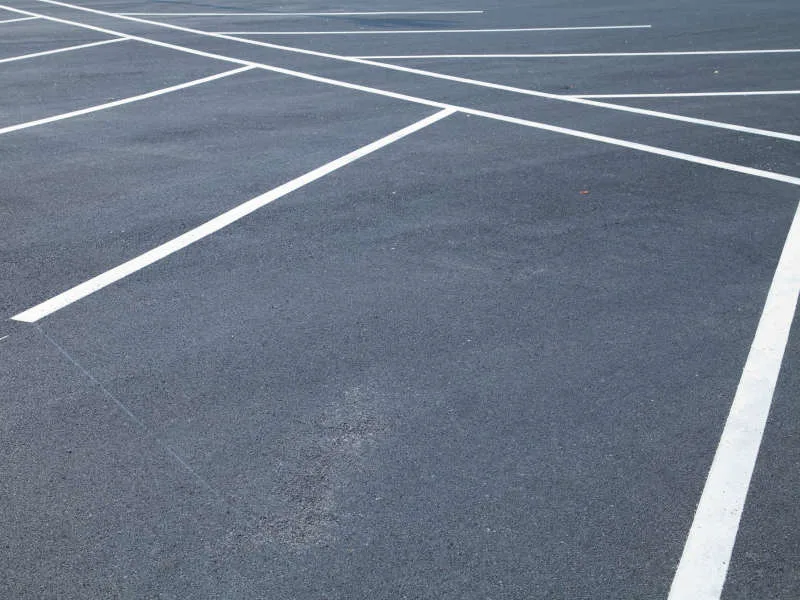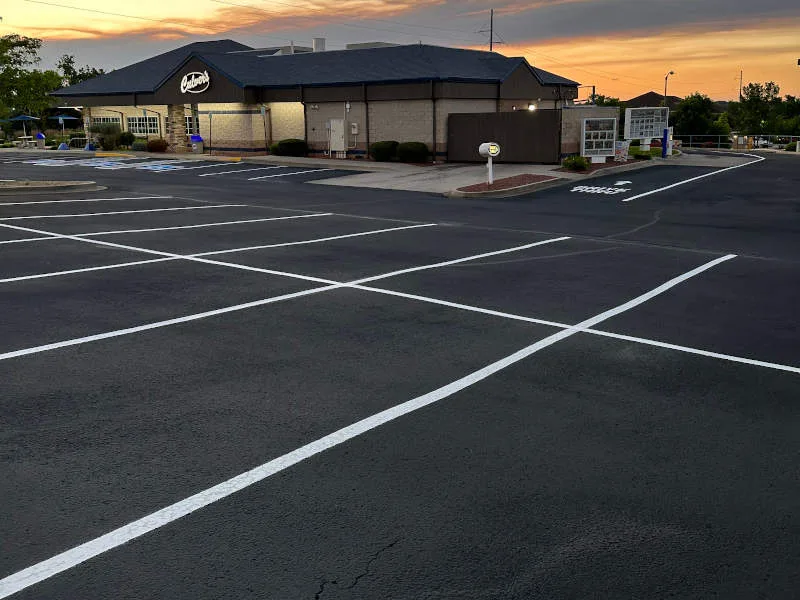Parking stall orientation is a critical design decision in parking lot layouts. The two most common options are angled stalls oriented diagonally to the aisle versus straight, perpendicular stalls aligned at 90 degrees. While both designs have advantages, the optimal orientation depends on considerations such as space efficiency, ease of navigation, safety, and suitability for the parking lot setting.
Angled stalls tend to maximize space along curbs and offer easier maneuverability, but perpendicular stalls provide simplicity and accommodate two-way traffic. Safety tradeoffs exist as well, with perpendicular stalls more prone to minor collisions and angled stalls presenting challenges when reversing. In choosing a stall orientation, factors like aisle dimensions, expected traffic patterns, and usage context help determine the ideal parking alignment for drivers. Careful stall design tailors the layout to the needs of the parking lot environment.

Angled Parking Stalls
Angled parking stalls are a common parking lot design where vehicles are positioned at an angle relative to the curb or aisle rather than being parked parallel to it. The angle can vary from 30 to 60 degrees, with 45 and 60 degrees being the most frequent.
The angle of the parking stalls has a major influence on the maneuverability for drivers as well as the efficient use of space. A shallower 30 degree angle provides easier access and exit from the stalls since drivers don’t have to turn their vehicles as sharply. However, this design is less space efficient. A steeper 60 degree angle allows more cars to fit along a given curb length, but drivers may find parking and leaving these stalls more difficult.
A 45 degree angled design provides a compromise between maneuverability and space efficiency. This is a popular choice for many parking lots. At this angle, drivers can easily back into and pull out of stalls with good visibility, while still allowing reasonably dense parking along the curb.
Some key advantages of angled parking include:
– Easier maneuvering into and out of stalls compared to parallel parking
– Better traffic flow as cars enter and exit the stalls in a consistent direction
– More efficient use of parking space relative to parallel parking
There are also a few potential disadvantages:
– Increased difficulty and safety issues when reversing out of angled stalls
– Limitation to one-way traffic flow in the aisle
– Reduced accessibility for disabled drivers compared to parallel stalls
Overall, angled parking offers significant benefits which explain its prevalence. But designers must carefully choose the angle to optimize for the needs of drivers versus space efficiency. Factors like traffic patterns, vehicle types, and parking user demographics help determine the ideal angle.

Straight Parking Stalls
Straight or perpendicular parking stalls are designed for vehicles to park at a 90 degree angle relative to the curb or parking aisle. This is the most common orientation for parking spaces.
A major advantage of perpendicular parking is the simplicity and consistency of the stall dimensions. Typically, each stall is designed to be the same rectangular size, with the length sufficient for an average vehicle plus room to maneuver. This uniform layout makes it easy to maximize parking along curbs and aisles. It also simplifies planning and laying out a parking lot since each stall uses about the same amount of space.
Additionally, perpendicular parking stalls naturally accommodate two-way traffic in the aisle. Drivers can easily navigate and turn into the stalls from either direction. This flexibility supports varied traffic flow needs.
However, perpendicular parking does require more precise driving skills, especially when pulling into tighter spaces between vehicles. Drivers need to accurately judge distances and alignments to avoid collisions. There is also an increased risk of minor parking lot damage like door dings or scraped bumpers due to the tight spacing.
In very cramped parking areas, navigating and successfully parking in these stalls can be challenging. Drivers may need to perform multi-point turns to align their vehicles properly. Perpendicular parking works optimally with adequate aisle clearances.
Overall, perpendicular stalls offer simplicity and efficient space usage, but do require more driving precision. Parking lot design considerations like stall size and aisle width help maximize the benefits of this standard parking orientation.
Comparing angled versus straight parking stalls:
When it comes to space efficiency, angled parking stalls tend to make better use of narrow parking aisles. By positioning vehicles at an angle, more can be fit along a given curb length compared to perpendicular parking. However, in parking lots with wide aisles, straight stalls can achieve similar or higher density parking since they align directly with the aisles.
In terms of driver convenience, angled stalls offer easier navigation into and out of the space at most angles. Drivers don’t have to maneuver their vehicles as precisely thanks to the diagonal alignment. But once parked, straight stalls provide simpler access in and out since vehicles are aligned with the direction of travel.
The safety aspects differ as well. With straight stalls, fender benders and minor collisions may occur more frequently given the tight spacing and precision required when parking between vehicles. However, when existing angled stalls, drivers must back out blindly into oncoming traffic, creating potential safety issues.
When choosing a design for a specific venue, angled stalls are often preferred in busy commercial areas like main street parking, shopping centers, and grocery stores. The angled alignment places vehicles in a consistent traffic flow pattern through the aisles. In contrast, straight stalls are very common in office buildings and residential settings where two-way aisle traffic and simplicity are priorities.
Parking stall orientation has a major impact on the convenience, safety, and efficiency of any parking lot design. Whether implementing angled versus perpendicular stalls requires weighing considerations such as space constraints, traffic patterns, and ease of navigation. By understanding the comparative advantages of each approach, parking lot owners and designers can select the ideal alignment for their specific needs. With careful planning and design, they can create stalls tailored for optimal driver experience, capacity, and operations. For those seeking local parking lot striping services, choosing providers experienced in layout best practices ensures spaces that safely and effectively meet the needs of parking lot users.

